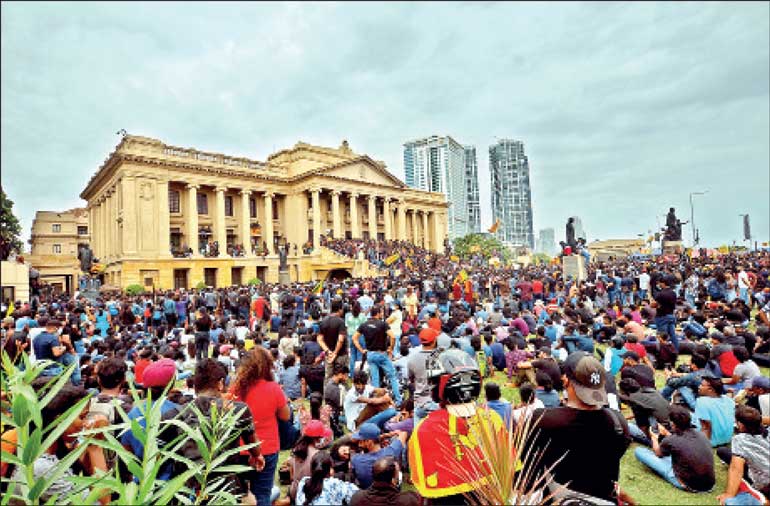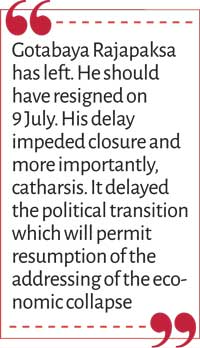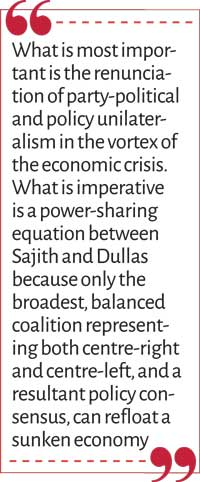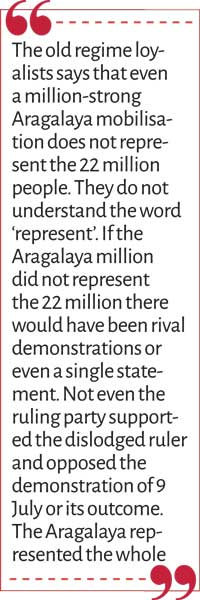Thursday Nov 27, 2025
Thursday Nov 27, 2025
Thursday, 14 July 2022 00:30 - - {{hitsCtrl.values.hits}}

If the JVP-NPP, FSP-IUSF and Aragalaya civic activists field joint lists, a Left and radical-democratic project has every chance of a historic electoral outcome – Pic by Shehan Gunasekara
 We each have our distinctive sensibilities which trigger our choices. I have my own favourite visual sequence; the one I consider the most emblematic of 9 July. A young man, bare-bodied, wearing low-rider jeans moves to the barricades and yells slogans; a water-cannon discharges a powerful jet of water which hits him full-on; he staggers and slides several yards back but doesn’t fall and rushes back to the barricades, more defiant than before.
We each have our distinctive sensibilities which trigger our choices. I have my own favourite visual sequence; the one I consider the most emblematic of 9 July. A young man, bare-bodied, wearing low-rider jeans moves to the barricades and yells slogans; a water-cannon discharges a powerful jet of water which hits him full-on; he staggers and slides several yards back but doesn’t fall and rushes back to the barricades, more defiant than before.
That, to me, defined the spirit of the people’s uprising which in turn revealed the spirit of the Sri Lankan people, the spirit of Sri Lanka, this island, our island.
That was the message of the Sri Lankan people and especially its youth, to its ruler Gotabaya Rajapaksa:
You tore up the terms of your contract, the contract that you entered into with us, the citizens and your electors. We hired you to do a job for us. We trusted you when you said you’d make things better but you made things worse in our everyday lives than we can remember. You broke our hearts. You betrayed our trust. You ruined our lives with your irrational policies fuelled by arrogance. You are a cruel, ignorant and foolish man. We shall not accept you as our leader any more. That leadership was a privilege not a right and you have forfeited that privilege. We shall not let you rule. We shall not let you or your clan occupy any official spaces in Sri Lanka. We are united, determined, forceful, unarmed. We want our country back. We are not afraid to die to liberate it from your callous, autocratic rule.
This was also the message that every future leader with despotic inclinations should bear in mind. It stems from the ethos of our people; of this island—the ethos of democratic republicanism, prizing and practicing people’s sovereignty.
Though not intended as such, it is also a message to rulers all over the world on behalf of their citizens.
Gotabaya Rajapaksa has left. He should have resigned on 9 July. His delay impeded closure and more importantly, catharsis. It delayed the political transition which will permit resumption of the addressing of the economic collapse.
In moments like these in world history, including most famously, European history, if the rulers do not leave and only retreat while entertaining thoughts of clinging on or a comeback, their exit and end are far more conclusive than otherwise might have been. It is when a rebellious people are compelled by the obduracy of rulers to make that final decisive push, that the revolution becomes conclusively – some would say dangerously, tragically—radicalised. Those who govern, including Prime Minister Wickremesinghe, must realise there are worse fates than exile or comfortable retirement in which to write one’s memoirs.
President/PM stakes
Sajith Premadasa, Dullas Alahapperuma and AKD are the names doing the rounds in the Presidential and Prime Ministerial stakes. While Sajith, having daringly stepped-up to the plate to challenge Gotabaya and offer an alternative in November 2019 has the most obvious case, all three represent a generational shift and are of progressive-reformist orientation.
What is most important is the renunciation of party-political and policy unilateralism in the vortex of the economic crisis. What is imperative is a power-sharing equation between Sajith and Dullas because only the broadest, balanced coalition representing both centre-right and centre-left, and a resultant policy consensus, can refloat a sunken economy.
Given that there are two posts, two serious contenders, and the high cost of failure to cooperate in the context of the crisis, it should be perfectly feasible if they only remember the old game-theory standard, the Prisoner’s Dilemma.
When did Gota go wrong?
My column in these pages well over a year ago was titled ‘Rajapaksa arc of political history begins to descend’. That was in May 2021, barely eight months after the mammoth 59% and two-thirds majority scored by the SLPP, followed by the 20th amendment, i.e., when the Rajapaksa project and its warhead the Gotabaya presidency were at their very zenith. (Rajapaksa arc of political history begins to descend | Daily FT)
My point here is not so much about personal prescience but about political predictability and therefore avoidability. It was foreseeable and therefore avoidable.
I was amused to read a friendly acquaintance of those years, Derana boss Dilith Jayaweera, a close confidant of Gotabaya Rajapaksa, telling the Guardian (London) something he had already told the Lankan media. He says that he saw the writing on the wall when he had a discussion on economic policy over dinner with Basil Rajapaksa who pretty much displayed the latter’s ignorance. It was followed-up by an encounter with Dr. P.B. Jayasundara and his voodoo economics. All that had been in 2021.
The reason for my amusement is that it was precisely at Dilith Jayaweera’s home, over dinner hosted by him way back in mid-2018, that I had an exchange of views with Gotabaya Rajapaksa regarding my critique of his economic policy, published in my regular column in the Daily FT’s sister paper the Daily Mirror. Shortly after Gotabaya’s triumphant Viyath Maga second conference at the Shangri-La hotel, which had been applauded across the board by the corporate community, I had written:
“… My second concern is the economic policy model that was rolled-out at the Shangri-La by Gotabaya… As…the dominant (Presidential) one, it will generate major structural contradictions, triggering a cycle of conflict.
The paradigm generates contradictions and resistance…The South-South axis, where social insensitivity, inequity and structural marginalization will trigger clashes with students, workers, peasants, fisherfolk and neighbourhood communities…The Democracy-Autocracy axis, where the top-down technocratic model itself requires authoritarianism…and will thereby erode legitimacy and trigger resistance.”
(‘Gotabaya’s Breakthrough’, Dayan Jayatilleka, At Variance, Daily Mirror, 23 May 2018.)
Contrary to Dilith’s re-telling, the original source of the problem wasn’t Basil or PB; it was Gota, and it didn’t take till 2021 to see that; it was publicly and privately flagged in 2018.
 Kumara Gunaratnam’s overstretch
Kumara Gunaratnam’s overstretch
Where and when does the democratic revolution end? The JVP opposes a parliamentary arrangement for an all-parties government, advocating instead an interim administration reflective of Aragalaya aspirations.
Going further, the FSP leader Kumara Gunaratnam rolled-out his vision at an extended televised media briefing. His principal point is that henceforth, the Aragalaya is the paradigm and sets the parameters. The Parliamentary mandate is obsolete. The Parliamentary parties should bow to the wishes of the Aragalaya as expressed in the Aragalaya Charter. Political power must be shifted outside Parliament to new People’s Councils. The Aragalaya did not take place within the existing Constitution so the latter is rendered obsolescent. A new Constitution must be quickly drafted and a Referendum must be held soon.
Each of these contentions can be logically contested—for instance the Aragalaya did take place within the Constitution, insofar as its cornerstone as a democratic republic, is popular sovereignty. Furthermore, it exercised its fundamental Constitutional rights, which was the argument used by the BASL to defend and protect the Aragalaya and its activists.
However, what the JVP-NPP and more radically, the FSP-IUSF say must be taken seriously into account, and accommodated to the degree desirable and possible. The problem is that the radical Left view does not take the larger picture, be it of the Sri Lankan situation or of world history and its lessons, into account. Moreover, in an ironic way, the Aragalaya ‘Jacobin Left’ echoes or reflects the errors of the Gotabaya regime it has helped dislodge.
The old regime loyalists says that even a million-strong Aragalaya mobilisation does not represent the 22 million people. They do not understand the word ‘represent’. If the Aragalaya million did not represent the 22 million there would have been rival demonstrations or even a single statement. Not even the ruling party supported the dislodged ruler and opposed the demonstration of 9 July or its outcome. The Aragalaya represented the whole people.
Where the Left mirrors the Gotabaya Far-Right, is that it projects as the agenda of the people, a radical project that not even the entirety of the Aragalaya endorsed. At its height the Aragalaya could have set up People’s Councils as advocated by Kumara Gunaratnam, i.e., the Soviet model that appeared in Russia in 1905 and reappeared in 1917 (on both occasions with Leon Trotsky elected as its head). No such thing happened here for almost 100 days. That was only to be expected because the most broadly unifying aim of the Aragalaya was manifestly clear: ‘Gota Go Home!’ To stretch that, as the JVP-NPP and the FSP-IUSF do, is to substitute the views of two of the political vanguards of the (originally non-partisan) Aragalaya, for the Aragalaya as a whole.
Kumara Gunaratnam’s assertion that the Parliament has also had its mandate cancelled by 9 July is quite a leap. How for instance, can the SJB, a new political party which resisted the MR-led Pohottuwa wave (59%) and became the parliamentary Opposition, have lost its mandate, simply because Comrade Kumara decrees so?
 ‘Cold Stream’ analysis
‘Cold Stream’ analysis
It was Professor Ronald Aronson, philosopher, Professor of Ideas at Brandeis University, occupying the chair once held by Herbert Marcuse (and an examiner of my doctoral thesis) who wrote that Marxism has two streams—a warm stream and a cold stream. By warm he didn’t mean fuzzy and friendly. By cold he didn’t mean heartless. He was referring to the romantic and radically rebellious and even utopian (‘warm’) stream on the one hand and the scientific and realist (‘cold’) stream respectively.
The JVP-NPP and more so the FSP-IUSF represent the ‘warm’ stream but not the ‘cold’ stream. That cold stream was manifest in Lenin’s grasp of the concrete situation and the balance of forces, best exemplified by his policies from the Brest-Litovsk Treaty through the New Economic Policy to his last writings.
History has demonstrated that an agenda as ambitious as that rolled-out by the FSP leader Kumara Gunaratnam and even the JVP-NPP, requires as a condition, three factors, none of which have been achieved even remotely:
I. The existing (capitalist) State machine with the armed forces at its core, has neither been disaggregated by defeat or entanglement in external war (Russia 1905, 1917), nor defeated in civil war/armed liberation (China 1949, Cuba 1959, Nicaragua 1979), nor won over by internal radicalisation and large-scale defection (Portugal 1974, Iran 1979).
II. Governmental power, leave alone state power, has not been assumed by the Lankan Left, nor does it even have a share. Bolivia changed its Constitution and introduced a radical redefinition as a plurinational state. Earlier Ethiopia had done the same, defining itself as a multinational state. Nepal too changed its Constitution, going federal. In all three cases the Left had assumed governmental power, and in the Ethiopian case, state power too, through civil war.
III. The mass struggle has neither a recognised single political vanguard (Russia’s Bolsheviks, China’s Communist Party, Cuba’s Rebel Army and the July 26th Movement) nor a unified vanguard of several revolutionary tendencies/factions (Nicaragua’s reunified Sandinistas, El Salvador’s FMLN, Uruguay’s Frente Amplio).
 Aragalaya results, Left prospects
Aragalaya results, Left prospects
While the Aragalaya uprising of 9 July 2022 has most certainly entered the history books, which all Sri Lankans must regard with pride, it must not be misperceived as unique, which is the founding mistake the Rajapaksas made when regarding the historic victory over the LTTE in May 2009. That was advertised as the first ever in the 21st century when it was the third, after Angola and Russia/Chechnya. The false notion of a unique achievement was the foundation stone of their downfall.
While historically distinctive in its marvellous massive mobilisation, 9 July was not unique even in terms of Sri Lanka’s post-independence history. A far more disciplined Police force shot dead eight people during the Hartal of 8-9 August 1953. The Hartal extended across the island from North to South, with the Federal party also participating. Women in chintz cloth-and-jacket baked hoppers on rail-tracks to stop trains. The Cabinet was evacuated to a US ship. The Prime Minister, the nation’s leader at the time, resigned. It was not a TV, let alone an IT/social media age.
The betrayal by the Left of the day—the LSSP and CPSL—was to call off the Hartal in two days instead of letting it run on to explore the limits of the politically possible and push them forward. The blunder of the Left was to fail to form an LSSP-CPSL-SLFP-Federal Party united front or at least an LSSP-CPSL-SLFP united front for the 1956 election. Had it been formed, Sinhala Only would never have been the war cry of the SLFP-MEP in 1955-56.
Today’s Left—JVP-NPP and FSP-IUSF—must not make the opposite mistake while repeating the same one. The opposite mistake of calling off the August 1953 Hartal in two days would be to push its objectives beyond the original Aragalaya agenda. Repeating the same mistake as the Old Left would be to fail to form a united front and contest every available electoral space.
If you take 50 years as cut-off, world history is replete with several waves of democratic popular upheavals toppling dictatorships, military juntas and single party rule. If you prefer a roughly 25–30-year cut-off there are many such including in Asia (Philippines, Indonesia).
In all these cases the endgame is always electoral, and within the existing or restored or newly created (in ex-communist ruled states) political frameworks, all of which are normal, standard and representative-democratic, not direct democratic. The most advanced outcomes are in Latin America, with leftwing Presidents and administrations elected, sometimes with ex-guerrilla personalities/parties elected to office.
As for a completely new Constitution reflecting the aspirations of the Aragalaya, this was attempted in Chile as an outcome of the popular protests against neoliberal austerity. That new constitution is still being deliberated upon and is pretty much gridlocked, because a deliberative, direct, radical-democratic exercise in Constitution-making even in a society as politically advanced and sophisticated as Chile, is a very difficult matter indeed, proving almost intractable. Instead, the major outcome of the Chilean street protests has been within impeccably Constitutional and electoral channels: the election of former student leader and left social democrat Gabriel Boric as President.
What the JVP-NPP and FSP-IUSF should do is to follow the international best practices of the Left. Form a left slate and/or rally round a single left candidate and run for every conceivable election.
In a situation where the Government is almost certain to implement an austerity package, a united Left can grow and stands a good chance of winning national elections.
The non-party civic resistance Aragalaya should form a political party called ‘Aragalaya’, a great brand, and run for office as did the leaders and activists of the Spanish Occupy Revolt of 2011, which converted itself into Podemos and eventually elected a Prime Minister at the second election it ran for.
If the JVP-NPP, FSP-IUSF and Aragalaya civic activists field joint lists, a Left and radical-democratic project has every chance of a historic electoral outcome.